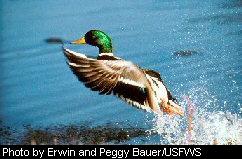

Waterfowl For All SeasonsBy Steve Wilson
The real answer is that waterfowl management is probably the most dynamic, science-based, cooperative system for managing an international resource found anywhere in the world. To really understand the whole process one must look at both the legal and administrative requirements, and the biological data-driven parts of the system. Waterfowl, with a few exceptions such as resident Canada geese, are migratory birds crossing both state and national borders on their annual flights between breeding and wintering areas. The United States has signed treaties with other countries governing management of all migratory birds including waterfowl. These treaties establish broad goals and guidelines and designate the respective national governments as the management authority in each country. The USFWS is the national agency with the responsibility for managing waterfowl in the United States. Although the respective national governments have the legal responsibility for managing waterfowl, including regulating hunting, individual states certainly have a vested interest in managing waterfowl that breed in, migrate through and/or winter in their state. The need to work cooperatively to achieve common goals was recognized in the 1930s. By 1940, regional committees, composed of state and federal waterfowl biologists as well as private individuals or organizations, were forming to address specific issues they had in common. The various committees merged in 1952 to form the Atlantic Flyway Council representing 17 states and six provinces in eastern Canada.
The hunting regulations for the seasons currently open are based in large part on what took place on the breeding grounds this past summer. Thousands of miles of aerial surveys were flown in May and June to estimate the number of ducks and geese on the breeding grounds and to assess habitat conditions. Additional surveys, in late June and early July estimated waterfowl nesting success. Data from these surveys provided an estimate of the total population after nesting, called their Fall Flight Forecast. This key data initiating the approval steps previously described, is not available until late July. Although the fall flight information is the last to be collected, it is by no means the only data used in the process. Information is being collected right now from hunters that will influence next year's regulations. Many hunters have been asked to participate in harvest and/or parts collection surveys. These surveys provide estimates of the number of hunters, number of days hunted, number of waterfowl harvested, species composition of the harvest, and age and sex ratios of the harvest. Thousands of birds are marked with leg bands or other markers each year. Reports of marked birds harvested provide estimates of the percentage of the population that is harvested. Waterfowl managers have a lot of good data but how is it all integrated and used? Even the best science is not always exact and there are different theories and uncertainty about the effects of management practices. Waterfowl biologists use a process called Adaptive Harvest Management (AHM) that recognizes uncertainty, considers competing theories, and most importantly allows for The goal is to maximize harvest over the long term. This obviously requires that a large, healthy and productive breeding population be maintained. There are four regulation packages— closed, restrictive, moderate and liberal. The AHM process has selected the liberal package for the past several years. The liberal package allows 60-day seasons and a total daily bag limit of six ducks with specific restrictions for certain individual species. Mathematical models have been developed that represent each of the competing theories using the data described above. The models predict the total harvest, harvest rate and succeeding years breeding population that would result from each regulatory package. Complex computer simulations for each model are projected into the future to recommend a regulations package. The adaptability and learning occurs when the actual results, as measured by the various surveys, are compared to the model predictions. The models are adjusted and the model that is most accurate is given more influence on the process. Anyone can participate in this process. Flyway Council or Technical Section meetings are open to the public and all proposed regulations are published in the Federal Register for public comment. If you are a hunter, you need to register in the Harvest Information Program, participate in surveys when asked, and report harvested marked birds. Steve Wilson is a wildlife biologist stationed in Elkins . |
 Have you ever wondered why waterfowl hunting regulations change from year to year? Or why the Migratory Bird Hunting Regulations brochure is not available until late August? If you're a waterfowl hunter you have almost certainly asked these questions. The short answer is that the states may establish their waterfowl hunting regulations only within guidelines determined annually by the U. S. Fish and Wildlife Service (USFWS) and these guidelines are not finalized until mid-August.
Have you ever wondered why waterfowl hunting regulations change from year to year? Or why the Migratory Bird Hunting Regulations brochure is not available until late August? If you're a waterfowl hunter you have almost certainly asked these questions. The short answer is that the states may establish their waterfowl hunting regulations only within guidelines determined annually by the U. S. Fish and Wildlife Service (USFWS) and these guidelines are not finalized until mid-August.